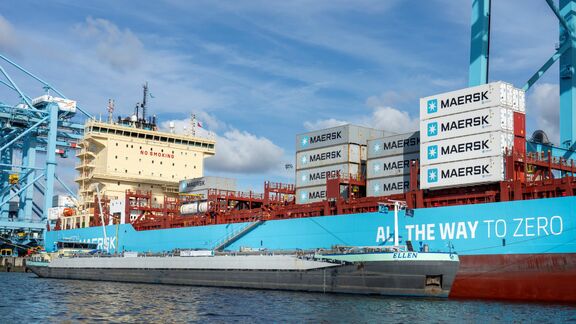Maersk vessel tanks green methanol for the first time in Rotterdam
Reading time: 3 minutes
On Monday 28 August, a new Maersk vessel arrived at APMT 2 to bunker green methanol. The vessel was built by Hyundai Mipo in the Korean city of Ulsan. It is on its way to Copenhagen, where its naming ceremony will be held.

During its maiden voyage, the vessel sailed on green methanol, which it also bunkered in Egypt. Maersk will be deploying the vessel between Northern Europe and the Baltic Sea. It will run on methanol, but it will also be able to switch to low-sulphur fuel oil.
The new 2,100 teu vessel is a stepping stone towards a much larger order of methanol vessels to be placed by Maersk. In 2021 and 2022, the shipping company ordered eighteen container ships – also from Hyundai – of about 16,000 teus for the Asia-Europe Route. They are set to become operational in 2024 and 2025.
X-Press Feeders
The methanol was supplied by OCI Terminal Europoort, part of Dutch enterprise OCI Global, which originates from DSM. The company stated that with this first supply, a foundation was laid for the construction of an infrastructure for the new fuel type, as well as the creation of ‘a framework for green methanol sailing routes in the future’.
Last month also saw the closing of an agreement with X-Press Feeders that will form the basis for the supply of green methanol in Rotterdam. This will be used for the new dual-fuel vessels as of next year. At the start of this year, OCI closed an agreement with Unibarge for the conversion of an existing bunker vessel into a methanol vessel, in order to facilitate the supply of methanol to sea-going vessels.
Ammonia
Methanol is a simple, toxic form of alcohol (CH4O). Its combustion results in the release of CO2, but if the fuel was produced a on renewable biomass basis, it may carry the ‘bio’ or ‘green’ label. Ahmed El-Hoshy, top executive with OCI Global, holds great expectations for the new fuel type and expects demand to grow to over six million tonnes annually in the coming years.
OCI Global plays an important part in the plans that the port of Rotterdam has for the future in reducing nett CO2 emissions. The company operates the only ammonia import terminal in that port, whose capacity will be upgraded from 400,000 tonnes to 1.2 million tonnes annually.
In the future, it is expected that part of that capacity can be supplied to the shipping industry as fuel. However, that idea is still in its infancy. OCI expects that the larger part of imported ammonia will be used to make hydrogen. The enterprise has already prepared a blueprint to increase the terminal’s capacity to three million tonnes per year, once the use of ammonia as a hydrogen carrier takes flight.